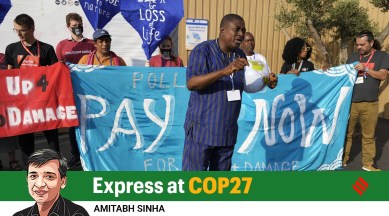Stay updated with the latest - Click here to follow us on Instagram
China, other large economies must also pay for loss and damage: EU
The proposal has received a lot of traction amongst NGOs and observer groups as well, creating a steady momentum for it in the last few days.

SUPPORTING THE demand first put forward by the small island countries, the European Union on Wednesday asserted that China must also be asked to contribute towards loss and damage finance, a new funding mechanism that is proposed to be set up to help poor countries hit by climate disasters.
“China is one of the biggest economies on the planet, with a lot of financial strength. Why should they not be made co-responsible for funding loss and damage? I fail to see that… In 1992, there was a reasoning behind this, which I can follow, but no longer in 2022,” EU’s climate policy head Frans Timmermans said, explaining why China needed to be treated differently now than when the climate negotiations had first begun.
monthly limit of free stories.
with an Express account.
EU’s position deepens the divide on the loss and damage finance, whose resolution is seen as one of the critical markers of success as the climate change conference here.
Timmermans did not mention India by name — he was asked about both India and China – but some small island states have said that India must also be asked to contribute. The US also wants both India and China, and possibly other major economies, to contribute.
When the demand had first come from the small island states, both India and China did not outright reject it, careful not to antagonise those countries who are allies on most other issues here. Instead, both countries had maintained that they sympathised with the small island states, and were willing to help, like they were helping through other measures, but that the main responsibility of providing climate finance rested with the developed nations.
A finance mechanism for loss and damage has been an old demand of developing countries and small island states. For years, this issue had lived on the periphery of COP meetings. This year, it was included in COP’s main agenda, which in itself was considered a major progress. But following it up with a decision to actually set up a finance facility for this purpose is proving to be much tougher.
Timmermans said EU was open to a setting up a new facility, but said a much better, and quicker, way to start helping the affected countries right away was to use the existing financial instruments.
“Setting up of a new facility is sometimes seen as a panacea, a solution for this… It is not going to be that. We are saying if we use existing financial instruments, we can start helping countries now. We all know, setting up new instruments can take years,” he said.
The US, and other developed countries, also want existing instruments to be used for this purpose. There is also a big difference on who the beneficiaries of loss and damage finance would be. Developing countries want every one of them to be able to access this money, but others have been insisting that only the most vulnerable and poor countries should benefit.
As negotiations moved into the last leg, another issue being keenly tracked is the Indian proposal for a decision calling for a phase-down of all fossil fuels. Last year, India had been caught off-guard when the final draft decisions included a mention of ‘phase-out’ of coal. It was seen directed at countries like India that continue to rely heavily on coal for electricity generation. India managed to get the reference changed to ‘phase-down’ at the last minute.
This time, however, New Delhi was much better prepared, and turned the tables on the developed countries by calling for a phase-down of all fossil fuels, not just coal. The argument is difficult to quibble with since all fossil fuels lead to emissions, and therefore, need to be phased-down. But it has caught many countries in the same kind of situation that India found itself in last year. The Indian proposal has won support from large number of developing countries and even EU, which uses large amount of oil and gas. But the United States is not on board, and neither is China.
Interestingly, a joint statement by BASIC countries comprising of India, China, Brazil and South Africa did not explicitly support the Indian position on this issue, even though Indian minister Bhupendra Yadav made a mention of it during his meeting his BASIC counterparts on Tuesday.
The proposal has received a lot of traction amongst NGOs and observer groups as well, creating a steady momentum for it in the last few days.